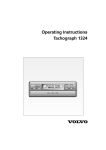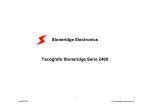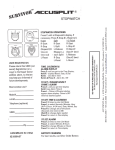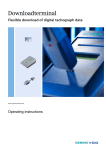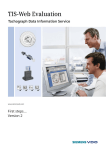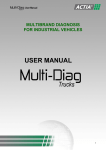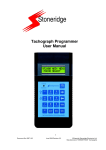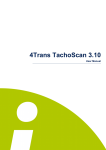Download 2400 User Manual Copyright © 2004 Stoneridge Electronics Ltd
Transcript
2400 User Manual 1 Copyright © 2004 Stoneridge Electronics Ltd USER HANDBOOK IMPORTANT INFORMATION Dirt ingress can lead to premature failure of the tachograph. Ensure that the device is closed at all times, except when fitting or removing charts. Do not leave the same paper charts in the tachograph for extended periods of time. There is a probability that eventually the styli will cut through the paper chart, causing irreparable damage to the tachograph if the vehicle is driven in this condition. Irrespective of the dangers of causing damage to the tachograph, there is also a legal obligation to remove the charts after 24 hours of use. Disconnect the electrical supply to the tachograph if: • Electrical welding is carried out on the vehicle. • Prolonged boost starting is anticipated. High-level transient voltage can cause permanent damage to the tachograph electronic circuits. Similarly, failure of other electrical components on the vehicle, for example the alternator regulator, may result in damage to the tachograph, which is permanently connected to the battery. The tachograph drawer is not capable of supporting loads in the open position. The EMC performance of the Veeder-Root 2400 tachograph unit complies with the requirements of EU Commission Directive 95/54/EC. 2400 User Manual 2 Copyright © 2004 Stoneridge Electronics Ltd CONTENTS I M P O R T A N T I N F O R M A T I O N .........................................................................................................2 CONTENTS .........................................................................................................................................................3 1.0 2400 SERIES TACHOGRAPH (WITH DISPLAY).........................................................................................5 1.1 2400 Tachograph With Remote Display......................................................................................................................5 2.0 DESCRIPTION OF THE CONTROLS...........................................................................................................7 2.1 2.2 2.3 2.4 2.5 2.6 Driver Duty Push-buttons ............................................................................................................................................7 LEDs ..............................................................................................................................................................................7 Mode Change Push-button ..........................................................................................................................................8 Advance Push-button...................................................................................................................................................8 Eject Push-button .........................................................................................................................................................8 Display ...........................................................................................................................................................................9 3.0 ADJUSTING THE TIME SETTING .............................................................................................................10 3.1 Clock Setting For Units Without Real Time Clock (RTC).........................................................................................10 3.2 Clock Setting For Units With Battery Backed Real Time Clock (RTC) ...................................................................10 4.0 MODE SETTING.........................................................................................................................................11 4.1 Normal and Trip Modes ..............................................................................................................................................11 4.2 DTC Value Display Mode...........................................................................................................................................11 4.3 DTC Time and Date Display Mode.............................................................................................................................12 5.0 INSERTION AND REMOVAL OF THE TACHOGRAPH CHART ...............................................................12 5.1 Crew Chart Insertion ..................................................................................................................................................13 5.2 Driver Chart Insertion .................................................................................................................................................13 5.3 Chart Removal ............................................................................................................................................................14 6.0 STATUS SETTING .....................................................................................................................................14 6.1 Setting the Driver Duty ...............................................................................................................................................14 6.2 Setting the Crew Duty.................................................................................................................................................14 7.0 CHART RECORDING WITH THE VEHICLE STATIONARY AND THE IGNITION OFF.............................14 8.0 FILLING IN TACHOGRAPH CHARTS .......................................................................................................15 2400 User Manual 3 Copyright © 2004 Stoneridge Electronics Ltd 8.1 Driver and Crew Chart Centre Fields ........................................................................................................................15 8.2 Manual Trace Indication .............................................................................................................................................15 8.3 Recording Vehicle Changes ......................................................................................................................................16 9.0 ‘POWER DOWN’ FEATURES ....................................................................................................................16 10.0 CARE AND MAINTENANCE OF THE TACHOGRAPH............................................................................16 10.1 Cleanliness................................................................................................................................................................16 10.2 Protecting the Tachograph from Damage ..............................................................................................................16 11.0 WARNING CODES...................................................................................................................................17 12.0 DIAGNOSTIC TROUBLE CODES (DTC) .................................................................................................17 LIST OF FIGURES Figure 1 Illustration of the Controls .....................................................................................................................................6 Figure 2 LED Sequence When Tachograph Carrying Out Automatic Functions ...........................................................19 Figure 3 LED Sequence When Operator Action Required ...............................................................................................19 Figure 4 Drawer Ejection, Position of the Safe ‘Push’ Position.......................................................................................20 Figure 5 Opening of the Tachograph Drawer ....................................................................................................................20 Figure 6 Display in NORMAL Mode....................................................................................................................................21 Figure 7 Display in TRIP Mode ...........................................................................................................................................21 Figure 8 Display in Clock Adjust Mode..............................................................................................................................21 Figure 9 Display in DTC Value Mode..................................................................................................................................21 Figure 10 Display in DTC Time and Date Mode.................................................................................................................22 Figure 11 Status of LEDs When Driver Chart Missing (Alternating On and Off) ............................................................22 Figure 12 Method of Crew Chart Insertion ........................................................................................................................23 Figure 13 Method of Driver Chart Insertion .......................................................................................................................24 Figure 14 Fields to be Completed at the Start of a Shift ..................................................................................................25 Figure 15 Fields to be Completed at the End of a Shift ....................................................................................................26 Figure 16 View of the Reverse Side of the Tachograph Chart .........................................................................................27 Veeder-Root Service Network..............................................................................................................................................28 2400 User Manual 4 Copyright © 2004 Stoneridge Electronics Ltd 1.0 2400 SERIES TACHOGRAPH (WITH DISPLAY) The 2400 series automatic electronic tachograph detailed within this user manual comprises an electronically controlled chart recorder within a drawer, which in turn locates in an ISO standard radio enclosure. This enables mounting in a variety of locations, ensuring that insertion and removal of the charts and operation of the controls can be easily achieved by the operator. The tachograph has been designed to comply with EC Regulations and thus displays and records speed and distance in metric units (kilometres per hour and kilometres respectively). In addition to displaying and recording the speed of the vehicle and the distance travelled, the tachograph incorporates an electronic real time clock, which controls the mechanism that rotates the charts and indicates the current time on the Tachograph’s display. The tachograph charts, upon which the speed, duty and distance travelled are recorded, are circular sheets of wax-covered paper, each of which features a pear-shaped central hole that is used to accurately locate it over the drive spindle of the electronic drive. Styli within the tachograph bear against the charts in order to mark them with indelible ‘traces’. Normally there are three trace types representing speed, duty and distance. However, if requested by the customer, the tachograph can be enabled to produce a fourth trace to record events such as off-road driving or engine revolution recording. The drawer, which contains the charts, the display and the controls, is electro-mechanically held in the locked closed position while the vehicle is being driven, and can only be opened, (in order to facilitate access for inserting or removing charts) when the vehicle is stationary and the ignition is switched on. The upper right hand area of the display (the ‘odometer’) identifies the distance travelled to the nearest 1/10 km as a seven-digit figure. The current time is displayed in the lower right hand area of the display as a four-digit figure (24-hour clock). The current speed of the vehicle is displayed on the left-hand side of the display. The tachograph is designed for use by up to two drivers, and thus two identical sets of driver-specific controls are provided adjacent to the display, each of which comprise a Driver Duty push-button and three Light Emitting Diodes (LEDs) that indicate the various work modes. Three further control push-buttons are provided on the tachograph, immediately below the display. The left-hand control is a Mode Change push-button, the centre control is an Advance push-button and the right hand control is an Eject push-button. The controls are identified on Figure 1 (overleaf). 1.1 2400 Tachograph With Remote Display The 2400 series tachograph may be installed as a component of a wider system, for example an instrument cluster. The information that is shown on the tachograph’s display, that is speed, odometer and time would thus also be displayed elsewhere on the vehicle’s instrument cluster. 2400 User Manual 5 Copyright © 2004 Stoneridge Electronics Ltd Driver 1 Duty Button Driving ‘Other Work’ LED (see Page 7) Driver 2 Duty Button LCD Display Non-driving ‘Other Work’ LED (see page 7) Rest LED Mode Change Button Advance Button PUSH here for Drawer Latch/Unlatch Drawer Eject Button Figure 1 Illustration of the Controls 2400 User Manual 6 Copyright © 2004 Stoneridge Electronics Ltd 2.0 DESCRIPTION OF THE CONTROLS 2.1 Driver Duty Push-buttons Two individual push-buttons are provided, respectively for the Duty and Off-Duty driver (if two drivers are present), for initiating a period of recorded duty. Within this manual, the Duty driver is referred to as the Driver and is allocated the left hand Driver Duty push-button (“1”), while the Off-Duty driver is referred to as the Crew and is allocated the right hand Driver Duty push-button (“2”). The mode of duty (as described below) for the Driver or the Crew is selected by the appropriate Driver Duty push-button and displayed by LEDs immediately below the relevant push-button. In order to change a mode of activity the Driver or Crew member will press their respective Driver Duty push-button a number of times, until the LED indicating the forthcoming mode of duty is illuminated. 2.2 LEDs Three LEDs are located below each Driver Duty push-button, with the respective legends 4, 1 and 2. In normal operation a single LED will be illuminated. This indicates that the Driver/Crew member is in one of the following activity modes, which correspond with the activities defined in the Council Regulation (EEC) 3821/85: 4 indicates working – used to record non-driving active work (such as loading a vehicle etc.) 1 indicates available – used to record time when a driver is waiting to start driving (such as waiting for passengers to arrive or for paperwork to be completed etc.) and to record time spent travelling as Crew in a moving vehicle. 2 identifies break or rest. Note: As an alternative, Council Regulation (EEC) 3821/85 allows all non-driving activities to be recorded under the single symbol 1. In this case, the symbol 4 is then not used for legal records. This alternative use is common in the UK, where the symbol 4 is used for convenience to indicate ‘out-of-scope’ or ‘off-road’ driving. There is no requirement for an LED to indicate normal driving activities, because the tachograph automatically switches to Driving mode when the vehicle begins to move. The LEDs can also be used to indicate when the tachograph is carrying out activities other than chart recording and to indicate problems that the device has identified. In some circumstances, the LEDs will flash in a distinguishable pattern to indicate that the tachograph is performing actions other than chart recording (for example aligning the chart or charts within the unit) as shown in Figure 2. 2400 User Manual 7 Copyright © 2004 Stoneridge Electronics Ltd Figure 2 LED Sequence When Tachograph Carrying Out Automatic Functions (page 19) If the tachograph has identified that an action is required, pushing the drawer in to unlock it for example, the three Driver LEDs and the three Crew LEDs will flash alternately, changing from Driver LEDs illuminated/Crew LEDs extinguished to Crew LEDs illuminated/Driver LEDs extinguished, as shown in Figure 3. Figure 3 LED Sequence When Operator Action Required (page 19) The LEDs are also used to indicate fault conditions, which are detailed in the WARNING CODES Section of this handbook (section 11.0). 2.3 Mode Change Push-button The Mode Change push-button, which is identified by a circular white dot (O), is used to select whether the display indicates the odometer reading (total recorded distance since the tachograph was installed) or the trip reading (recorded distance since the trip reading was last reset), and to adjust the time. Determining whether the odometer or trip reading is displayed is described in the MODE SETTING Section while the clock adjustments are described in the ADJUSTING THE TIME SETTING Section. 2.4 Advance Push-button The Advance push-button, which is identified by a white plus sign (), is used to reset the trip value to zero and to alter individual field settings of the digital clock. Setting the trip value to zero is detailed in the MODE SETTING Section while the clock adjustments are described in the ADJUSTING THE TIME SETTING Section. 2.5 Eject Push-button • The Eject push-button, which is identified by the white legend ©, is pressed prior to opening the drawer. When the Eject pushbutton is pressed, a 3 mm radial line is drawn on the Driver chart between the Duty and Distance traces (to record that the drawer is being opened), then the styli are withdrawn from the charts. • While the styli are retracting, the LED mode changes to the automatic sequence shown on Figure 2 (indicating that the tachograph is carrying out internal functions – in this case stylus retraction). Once the styli are fully retracted, the LED mode reverts back to the flashing sequence shown on Figure 3, indicating that the drawer can now be opened by the operator. • This is achieved by pushing the drawer at the oval emboss as shown on Figure 4 and then opening the drawer as shown on Figure 5. After the drawer has been opened, the LEDs revert to their previously selected status indicating the current driver duty (or duties if the tachograph is arranged for two driver operation). 2400 User Manual 8 Copyright © 2004 Stoneridge Electronics Ltd Notes: 1. DO NOT push any other part of the drawer fascia when ejecting it. 2. The Eject push-button is only active when the ignition is on and the vehicle is stationary. It is not possible to open the drawer when the vehicle is in motion or when the vehicle ignition is off. 3. The Eject push-button is not active when the electrical supply to the tachograph is interrupted. If it is not possible to restore the power, the drawer will require to be released by an approved service engineer using procedures and special tools, which are outside the scope of this manual. Figure 4 Drawer Ejection, Position of the Safe ‘Push’ Position (page 20) Figure 5 Opening of the Tachograph Drawer (page 20) 2.6 Display The display area of the fascia provides a continuous digital (liquid crystal) indication of all information that the operator will require during a trip. Four distinct modes of display are available, NORMAL, TRIP, DTC VALUE DISPLAY MODE and DTC TIME AND DATE DISPLAY MODE. Note: For the 12V version, only Normal and Trip Modes are available. The digital display features the following three distinct information areas: • The upper right hand area of the display alternatively indicates the odometer reading (the total [cumulative] distance in kilometres [km] travelled) or the trip reading (the total distance travelled [km] since the trip figure was last reset), depending on which display mode has been selected (NORMAL or TRIP respectively). In order to identify the display mode that is active, the trip distance is prefixed with the letters ‘Tr’. Mode selection is described in the MODE SETTING Section. • The lower right hand area of the display indicates the time in 24-hour clock format as a four-figure number, with a flashing colon separating the hours from the minutes. The clock adjustments are described in the ADJUSTING THE TIME SETTING Section. • The left-hand side of the display indicates the current speed of the vehicle, expressed in kilometres per hour (km/h). Figure 6 Display in NORMAL Mode (page 21) Figure 7 Display in TRIP Mode (page 21) 2400 User Manual 9 Copyright © 2004 Stoneridge Electronics Ltd 3.0 ADJUSTING THE TIME SETTING 3.1 Clock Setting For Units Without Real Time Clock (RTC) Changing the displayed time, which corresponds with the real time internal clock setting of the tachograph, can only be carried out with the drawer in the OPEN position. The tachograph must then be switched to a Time Adjust mode, which is achieved by pressing the Mode Change push-button (O) for more than 3 seconds. In this mode, the Mode Change push-button (O) is used to switch between the various time fields while the Advance push-button () is used to increase the displayed value in the current field. When Time Adjust mode is first selected the hours (left-hand) field flashes and can be adjusted by momentarily pressing the Advance push-button () [for an individual increment] or continuously pressing the Advance push-button () [for larger alterations] until the required value is shown in the field. This procedure is repeated for the other five fields, which alternate between left hand and right hand until all six fields are set, at which time the current set time is displayed. This setting procedure is shown in tabular form below. Time Field Hours (left hand field) Action 1 Press the Mode Change Push-button (O) Minutes (right hand field) Month (right hand field) Press the Mode Change Push-button (O) Day (left hand field) Press the Mode Change Push-button (O) Second two digits of the year (right hand field) First two digits of the year (left hand field) Press the Mode Change Push-button (O) Press the Mode Change Push-button (O) Press the Mode Change Push-button (O) Action 2 When the left hand field is flashing press the Advance pushbutton () repeatedly until the correct hour time is flashing When the right hand field is flashing press the Advance pushbutton () repeatedly until the correct minute time is flashing When the right hand field is flashing press the Advance pushbutton () repeatedly until the correct month number is flashing When the left hand field is flashing press the Advance pushbutton () repeatedly until the correct day number is flashing When the right hand field is flashing press the Advance pushbutton () repeatedly until the figure for the second two year digits is flashing. When the left hand field is flashing press the Advance pushbutton () repeatedly until the figure for the first two year digits is flashing Press the Mode push-button again on completion. 3.2 Clock Setting For Units With Battery Backed Real Time Clock (RTC) In a unit with a battery-backed clock the universal time is stored by the unit when power is removed. The driver can only adjust an OFFSET around that time. The ranges of the offsets are –23h 59m to +23h 59m. 2400 User Manual 10 Copyright © 2004 Stoneridge Electronics Ltd To adjust the time Offset, press the Mode Change push-button (O) for more than 3 seconds (with the drawer open) and then adjust as follows: Time field Action 1 Hours (left hand field) Press the Mode Change push-button (O) Minutes (right hand field) Press the Mode Change push-button (O) Action 2 When the left-hand field is flashing, press the Advance push-button () repeatedly until the correct hour time is flashing. When the right hand field is flashing, press the Advance push-button () repeatedly until the correct minute time is flashing. When the clock adjust mode is entered both the time and date will be shown on the screen. Figure 8 Display in Clock Adjust Mode (page 21) The time stops flashing if no button is pressed after 10 seconds. 4.0 MODE SETTING 4.1 Normal and Trip Modes Two display modes are available by pressing the Mode Change push-button (O) only. In both modes the display shows the current set time. In the NORMAL mode the upper right hand area of the display shows the odometer, which is the cumulative record of distance travelled in kilometres (km). In the TRIP mode the upper right hand area of the display shows the distance travelled, in kilometres (km) since the trip value was last reset. Repeated pressing of the Mode Change push-button (O), for less than 3 seconds each time, will switch the display between Normal and Trip modes. In order to reset the trip display to zero, ensure that the display is in the Trip mode (Note: the trip distance is prefixed with the letters ‘Tr’) then press the Advance push-button () for more than 3 seconds. 4.2 DTC Value Display Mode The DTC display must be enabled in the 2400 tachograph for this mode to be possible. To enter the DTC Value Display Mode, press the (O) and () buttons simultaneously. The screen of the tachograph would appear as shown in Figure 9. Figure 9 Display in DTC Value Mode (page 21) 2400 User Manual 11 Copyright © 2004 Stoneridge Electronics Ltd The DTC Value Display shows the DTC list position index, occurrence count and DTC number. Press the () repeatedly to browse through the DTCs. If there are no errors stored, all values are replaced with ‘-‘ and the unit returns to normal mode after 5 seconds. Otherwise press the © button to exit this mode. 4.3 DTC Time and Date Display Mode The DTC display must be enabled in the 2400 tachograph for this mode to be possible. To enter the DTC Time and Date Display Mode, press the (O) and () buttons simultaneously and release, then press the (O) button once. The screen of the tachograph would appear as shown in Figure 10. Figure 10 Display in DTC Time and Date Mode (page 22) The DTC Time and Date Display shows the DTC list position index, date and time. If there are no errors stored all values are replaced with ‘-‘ and the unit returns to normal mode after 5 seconds. Otherwise press the © button to exit this mode. 5.0 INSERTION AND REMOVAL OF THE TACHOGRAPH CHART The Driver and Crew charts are both located within the tachograph drawer when in use. Each chart has a central location aperture, which is ‘pear-shaped’. When the drawer is in the OPEN position, the drive mechanism can be rotated easily by hand. When the drawer is closed, the drive mechanism is automatically driven to a position corresponding with the current time setting. During normal operation, if the tachograph detects that the Driver chart is missing, the driver LEDs will alternately all light simultaneously and all extinguish simultaneously a number of times (for 10-15 seconds), after which they will remain extinguished, as shown on Figure 11. Similarly for the Crew, under normal operation, if the tachograph detects that the Crew chart is missing and the duty mode is NOT rest, the Crew LEDs will alternately all light simultaneously and all extinguish simultaneously a number of times then remain extinguished (Note: if the crew duty mode is rest the Crew LEDs will switch off without flashing). Figure 11 Status of LEDs When Driver Chart Missing (Alternating On and Off) (page 22) The chart insertion method for the Driver differs slightly from the insertion method for the Crew and thus the two procedures are individually described below. It should also be noted that if Driver and Crew charts are both required, the Crew chart must be fitted first. It is not necessary to fit the Crew chart when the tachograph is being used for single Driver operation. However, after the Driver chart is installed and the drawer is closed, the Crew LEDs may indicate that a chart is missing (as described above). 2400 User Manual 12 Copyright © 2004 Stoneridge Electronics Ltd 5.1 Crew Chart Insertion • If the tachograph drawer is closed, press the Eject push-button (see section 2.5). Note: the drawer can only be opened when the vehicle is stationary with the ignition switched on. • Observe the LEDs as their mode changes to individually illuminating in turn, as shown on Figure 2 (which indicates that the styli are being withdrawn), and then to alternately flashing (Driver LEDs and Crew LEDs), as shown on Figure 3 (which indicates that the drawer can be opened). • Push the front of the drawer in the position shown on Figure 4, which will cause the drawer to unlatch and spring forward to the partly open position. The LEDs then revert to reflect the currently selected Duty status. • The drawer can now be carefully pulled out to its fully extended position, as shown on Figure 5. The chart table, upon which the chart locates, is now exposed to facilitate easy insertion of the chart. • With the face of the chart uppermost, insert the edge of the chart through the transverse slot between the front and rear chart platens, as shown in Figure 12. Locate the chart such that the pear-shaped hole in the centre of the chart locates over the corresponding pear-shaped drive spindle. Figure 12 Method of Crew Chart Insertion (page 23) The Driver chart can now be inserted as described below. 5.2 Driver Chart Insertion • If the tachograph drawer is closed, press the Eject push-button (see section 2.5). Note: the drawer can only be opened when the vehicle is stationary with the ignition switched on. • Observe the LEDs as their mode changes to individually illuminating in turn, as shown on Figure 2 (which indicates that the styli are being withdrawn), and then to alternately flashing (Driver LEDs and Crew LEDs), as shown on Figure 3 (which indicates that the drawer can be opened). • Push the front of the drawer in the position shown on Figure 4, which will cause the drawer to unlatch and spring forward to the partly open position. The LEDs then revert to reflect the currently selected Duty status. • The drawer can now be carefully pulled out to its fully extended position, as shown on Figure 5. The chart table, upon which the chart locates, is now exposed to facilitate easy insertion of the chart. • With the face of the chart uppermost, insert the edge of the chart such that its edge locates under the two location fingers at the rear of the chart table, as shown in Figure 13. Locate the chart such that the pear-shaped hole in the centre of the chart locates over the corresponding pear-shaped drive spindle. Figure 13 Method of Driver Chart Insertion (page 24) 2400 User Manual 13 Copyright © 2004 Stoneridge Electronics Ltd After the chart (or charts for 2-driver operation) is inserted, close the drawer by pushing it forward in the position shown on Figure 4 until it is mechanically latched. The tachograph will now carry out internal procedures to align the charts to correspond with the correct time and to deploy the styli (as indicated on Figure 2). These procedures, which are automatic operations, are completed after a short time. 5.3 Chart Removal • Press the Eject push-button (see section 2.5). Note: the drawer can only be opened when the vehicle is stationary with the ignition switched on. • Observe the LEDs as their mode changes to individually illuminating in turn, as shown on Figure 2 (which indicates that the styli are being withdrawn), and then to alternately flashing (Driver LEDs and Crew LEDs), as shown on Figure 3 (which indicates that the drawer can be opened). • Push the front of the drawer in the position indicated on Figure 4, which will unlatch the drawer and cause it to spring forward to the partly open position. The LEDs then revert to the most recently selected Duty mode status. • The drawer can now be carefully pulled out to its fully extended position, as shown on Figure 5. The chart table, upon which the charts locate, is now exposed to facilitate easy removal of the chart (or charts). 6.0 STATUS SETTING 6.1 Setting the Driver Duty Observe the LEDs below the Driver 1 Duty push-button. If the LED corresponding with the required duty is not illuminated, press the Driver 1 Duty push-button once or twice until the required duty LED is illuminated. NOTE: The driver status automatically reverts to DRIVE when the vehicle begins to move, reflected by a Drive trace on the Driver 1 Chart, although the LEDs will continue to reflect the most recently selected mode for Driver 1. 6.2 Setting the Crew Duty Observe the LEDs below the Driver 2 Duty push-button. If the LED corresponding with the required duty is not illuminated, press the Driver 2 Duty push-button once or twice until the required duty LED is illuminated. 7.0 CHART RECORDING WITH THE VEHICLE STATIONARY AND THE IGNITION OFF If all of the following conditions are present, • Driver duty (and if appropriate, Crew duty) set to Rest. • Zero speed. 2400 User Manual 14 Copyright © 2004 Stoneridge Electronics Ltd • • Ignition Off. Fourth trace Off (i.e., no events and/or zero engine speed). then the speed rack will remain positioned at the zero speed mark and the duty rack will position itself in the Duty Rest position. The chart table will continue to move and this will cause minimal speed and duty traces to be drawn, but NO distance trace will be recorded. 8.0 FILLING IN TACHOGRAPH CHARTS Note: This is a legal requirement – see Council Regulation (EEC) No. 3821/85 Article 15 for full a description. 8.1 Driver and Crew Chart Centre Fields Each driver and crew member must have their own chart, which is fitted into the tachograph as described in section 5.0, ‘Insertion and Removal of Tachograph Charts’. At shift changes, the charts must be exchanged in order to ensure that the chart for the current driver is always in the top operating position and the chart for the current crew member (if there is one) is fitted in the lower operating position. At the beginning of a shift, a blank chart is provided to the driver (and to the crew member in the case of two-person operation). A chart requires the fields identified on the diagram shown in Figure 14 to be manually filled in. Note: For single driver operation, the operation of the tachograph with only a Driver chart inserted is acceptable. However, NEVER insert only a crew chart into the tachograph as no Driver 1 details will be recorded and this is against the law. Figure 14 Fields to be Completed at the Start of a Shift (page 25) At the end of the shift, the fields indicated in Figure 15 must be filled in. Figure 15 Fields to be Completed at the End of a Shift (page 26) 8.2 Manual Trace Indication In the event that a chart has to be filled in manually, for example carrying out activities or resting when the chart holder is not allocated to a vehicle or in the event of a tachograph failure, the reverse side of the chart must be filled in with a hand drawn duty trace showing the various duty modes during the shift. Note: Do not press too hard when drawing a manual trace, in order to avoid marking the front of the chart. The manual trace runs anti-clockwise with respect to time, which is the reverse of the direction that the automatic trace runs. 2400 User Manual 15 Copyright © 2004 Stoneridge Electronics Ltd 8.3 Recording Vehicle Changes In the event that a driver has to transfer between vehicles during a shift, there is space, on the reverse centre of a chart, to record trip details of up to three additional vehicles. For each additional vehicle, the details required are: the registration number of the vehicle, the time at which duty commences, the start and finish odometer readings for the vehicle and the trip distance (the difference between the start odometer reading and the finish odometer reading). The three areas for recording the additional vehicle details are identified by the numbers 2, 3 and 4 respectively within the centre of the chart, as shown in Figure 16. Figure 16 View of the Reverse Side of the Tachograph Chart (page 27) 9.0 ‘POWER DOWN’ FEATURES In order to protect the tachograph and avoid unnecessary draining of the vehicle battery, the tachograph will enter a ‘Power Down’ mode if it detects a lack of activity. This condition occurs immediately if the ignition is switched off and the tachograph does not contain a chart. If the ignition is off and a chart is present the ‘power down’ condition occurs after 24 hours of non-activity. Note: Power-down will not occur if the drawer is open. 10.0 CARE AND MAINTENANCE OF THE TACHOGRAPH 10.1 Cleanliness Ensure that the tachograph drawer is CLOSED AND LATCHED AT ALL TIMES – except when fitting and removing charts. This will prevent the ingress of contaminants which could lead to premature failure of the tachograph. If it is necessary to clean the outside of the tachograph use a mild detergent solution ONLY. Avoid the use of solvents that could permanently damage the plastic fascia. 10.2 Protecting the Tachograph from Damage • DO NOT leave charts in the tachograph for extended periods of time. In addition to the legal obligation to remove charts after 24 hours, the 2400 tachograph stops recording on the chart after 24 hours. • Disconnect the tachograph from its electrical supply if electrical welding is carried out on the vehicle or if prolonged boost starting of the vehicle is anticipated or if high-level transient voltages are anticipated. Note: Failure of other electrical components on the vehicle, for example the alternator regulator, could damage the tachograph, as it is permanently connected to the battery. • The tachograph drawer is NOT designed to support weight when in the open position. • When opening the Tachograph, the ONLY acceptable place to push the drawer is identified on Figure 4. 2400 User Manual 16 Copyright © 2004 Stoneridge Electronics Ltd 11.0 WARNING CODES Three possible types of fault condition are indicated by the LEDs and identified in the table below. WARNING CODE Driver Crew Driver or Crew Driver and Crew LED INDICATION All three Driver LEDs alternate between all illuminated for a short period and all extinguished for a slightly longer period. All three Crew LEDs alternate between all illuminated for a short period and all extinguished for a slightly longer period. All three Driver LEDs and all three Crew LEDs flash alternately. All three Driver LEDs and all three Crew LEDs flash simultaneously. REASON No Driver Chart (See Driver Chart insertion section). No Crew Chart (See Crew Chart insertion section). Driver or Crew required to press front of drawer to open. No Driver or Crew chart detected. The conditions in which the LEDs cycle (automatic functions) and alternately flash (indicating that operator intervention is required), previously detailed in the ‘Description of the Controls’ section, override any of the Warning codes. 12.0 DIAGNOSTIC TROUBLE CODES (DTC) DTC A00C 9010 Description Internal Error LCD Error A400 9060 9061 Tachograph Power Supply Drawer Error Speed Rack Error Yes Yes Yes Power interruption. Drawer catch failure. Speed rack motor or opto failure. 9062 Duty Rack Error Yes Duty rack motor or opto failure. 9063 9064 Cam Error Chart Table Error Yes Yes Cam motor or opto failure. Chart table motor or opto failure. 2400 User Manual Stored Yes Yes Remarks Internal device error. Fascia communications. 17 Suggested Action Reset tachograph and re-test. Check fascia functions (keypress, display, etc.) Check power supply and connections. Check drawer function. Check charts inserted correctly. Reset tachograph and re-test. Check charts inserted correctly. Reset tachograph and retest Reset tachograph and retest. Check charts inserted correctly. Reset tachograph and retest. Copyright © 2004 Stoneridge Electronics Ltd Sender-Tachograph Key/Serial Number Mismatch Sender-Tachograph Communications Problem Yes Encrypted data errors. Yes Yes 900B CANbus Communication Error With Instrument Cluster CANbus Off Yes Encrypted communications errors (encrypted sender) or complimentary signal failure (4 wire sender) or sender disconnection. “Cluster present” message not being received. CANbus error. 900A CANbus Error Yes CANbus in passive error mode. 9430 V-pulse Output Error Yes Monitoring of V-Pulse output. 900F Keyboard Error Yes A00E Calibration Error Yes Key jammed or held for excessive period. Requires configuration A050 Driving without Chart No 9051 No Driver Chart Present No 9052 No Crew Chart Present No A822 A423 A411 2400 User Manual Speed pulses detected with drawer open, driver chart missing or chart recording complete. Drawer closed with no driver chart present. Drawer closed with no crew chart present. 18 Re-pair tachograph to Sender. Check wiring to B-socket. Check tachograph settings – Sender Type. Re-pair sender if necessary. Check wiring to B-socket. Check if instrument cluster matches tachograph display. Check wiring. Check tachograph settings – CANbus enabled and Customer Type. Possibly no CANbus present in vehicle Check tachograph settings - possibly no CANbus present in vehicle. Disconnect all V-pulse supported equipment. Retest tachograph. If DTC does not reappear, suspect V-pulse driven equipment. Check all keys/buttons on tachograph. Retest tachograph. Check tachograph settings – Install Date and Service Delay. Retest tachograph. The service delay applies to tachographs fitted with a Real-time clock only. Ensure driver chart present and drawer properly closed. Insert driver chart Insert crew chart if required. Copyright © 2004 Stoneridge Electronics Ltd Figure 3: LED Sequence When Operator Action Required. Figure 2: LED Sequence When Tachograph Carrying out Automatic Functions. 2400 User Manual 19 Copyright © 2004 Stoneridge Electronics Ltd Figure 5: Opening of the Tachograph Drawer. Figure 4: Drawer Ejection, Position of the Safe ‘Push’ Position. 2400 User Manual 20 Copyright © 2004 Stoneridge Electronics Ltd Figure 8: Display in Clock Adjust Mode. Figure 6: Display in NORMAL Mode. Figure 9: Display in DTC Value Mode. Figure 7: Display in TRIP Mode. 2400 User Manual 21 Copyright © 2004 Stoneridge Electronics Ltd Figure 11: Status of LEDs When Driver Chart Missing (Alternating On and Off). Figure 10: Display in DTC Time and Date Mode. 2400 User Manual 22 Copyright © 2004 Stoneridge Electronics Ltd Drawer Slot. Figure 12: Method of Crew Chart Insertion. 2400 User Manual 23 Copyright © 2004 Stoneridge Electronics Ltd Driver chart location. Figure 13: Method of Driver Chart Insertion. 2400 User Manual 24 Copyright © 2004 Stoneridge Electronics Ltd Driver’s name. Place of Departure. Vehicle Registration. Departure date. Departure odometer reading. Figure 14: Fields to be Completed at the Start of a Shift. 2400 User Manual 25 Copyright © 2004 Stoneridge Electronics Ltd Location at Shift End. Date at Shift End. Odometer reading at Shift End. Distance travelled (difference between odometer readings). Figure 15: Fields to be Completed at the End of a Shift. 2400 User Manual 26 Copyright © 2004 Stoneridge Electronics Ltd Vehicle Registration. Start Time at New vehicle. End Odometer Reading. Start Odometer Reading. Trip Distance. Figure 16: View of the Reverse Side of the Tachograph Chart. 2400 User Manual 27 Copyright © 2004 Stoneridge Electronics Ltd Stoneridge Electronics Ltd VEEDER-ROOT: SERVICE NETWORK www.stoneridge-electronics.com/“AFTERMARKET DIVISION” -> /vrservice.html TACHOGRAPH INSTALLATION, REPAIR, SERVICING AND CALIBRATION In the European Union, tachograph installation and calibration is subject to laws which are enforced by the National Authorities. It is imperative that any tachograph servicing or repair is carried out ONLY at government approved centres. This complies with the law (see Council Regulation (EEC) No. 3821/85 Article 16) and ensures that any work done is carried out only by properly trained specialist staff. A full list of Stoneridge Electronics/Veeder-Root International Distributors and Service Centres is included from page 120 in the Main 2400 Tachograph User Manual (part number 5973-020 Rev 4.0) 2400 User Manual 28 Copyright © 2004 Stoneridge Electronics Ltd




























